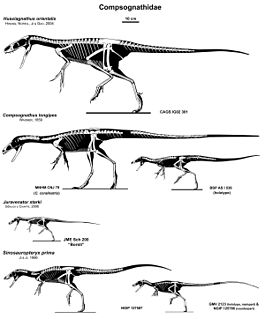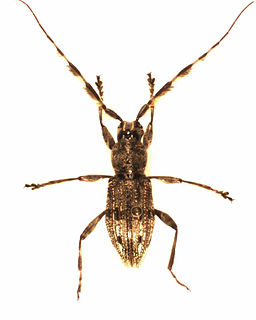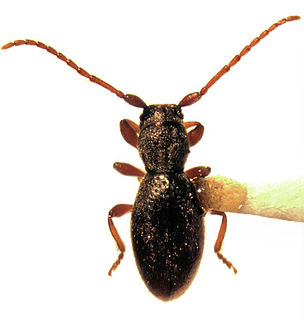Related Research Articles

Compsognathus is a genus of small, bipedal, carnivorous theropod dinosaur. Members of its single species Compsognathus longipes could grow to around the size of a turkey. They lived about 150 million years ago, during the Tithonian age of the late Jurassic period, in what is now Europe. Paleontologists have found two well-preserved fossils, one in Germany in the 1850s and the second in France more than a century later. Today, C. longipes is the only recognized species, although the larger specimen discovered in France in the 1970s was once thought to belong to a separate species and named C. corallestris.

The bushwren, bush wren, or mātuhituhi in Māori, was a very small and almost flightless bird that was endemic to New Zealand. It had three subspecies on each of the major islands of New Zealand, the North Island, South Island, and Stewart Island and nearby smaller islands. The species disappeared gradually after the introduction of invasive mammalian predators, last being seen on the North Island in 1955 and the South Island in 1968. Attempts were made to save the remaining population on small islands off Stewart Island, but they ultimately failed with the death of the last remaining known birds in 1972.

Compsognathidae is a family of coelurosaurian theropod dinosaurs. Compsognathids were small carnivores, generally conservative in form, hailing from the Jurassic and Cretaceous Periods. The bird-like features of these species, along with other dinosaurs such as Archaeopteryx inspired the idea for the connection between dinosaur reptiles and modern-day avian species. Compsognathid fossils preserve diverse integument — skin impressions are known from four genera commonly placed in the group, Compsognathus, Sinosauropteryx, Sinocalliopteryx, and Juravenator. While the latter three show evidence of a covering of some of the earliest primitive feathers over much of the body, Juravenator and Compsognathus also show evidence of scales on the tail or hind legs. Ubirajara, described in 2020, had elaborate integumentary structures on its back and shoulders superficially similar to the display feathers of a standardwing bird-of-paradise, and unlike any other non-avian dinosaur currently described.

The long-footed potoroo is a small marsupial found in southeastern Australia, restricted to an area around the coastal border between New South Wales and Victoria. It was first recorded in 1967 when an adult male was caught in a dog trap in the forest southwest of Bonang, Victoria. It is classified as vulnerable.
The Kashmir cave bat is a species of vesper bat. It is endemic to the Western Himalayas of South Asia. It is found in the Western Himalayan broadleaf forests ecoregion, within Bhutan, India, Nepal, Pakistan, and Afghanistan.

The Savanna swamp shrew is a species of mammal in the family Soricidae. It is endemic to Nigeria. Its natural habitat is swamps. It is threatened by habitat loss.

Libo County is a county of southern Guizhou province, China, bordering Guangxi to the south. It is under the administration of the Qiannan Buyei and Miao Autonomous Prefecture.

Parmenini is a tribe of longhorn beetles of the subfamily Lamiinae.

Somatidia is a genus of longhorn beetles of the subfamily Lamiinae, containing the following species:

Panulirus longipes, the longlegged spiny lobster, is a species of spiny lobster that lives on shallow rocky and coral reefs in the tropical Indo-Pacific region. The International Union for Conservation of Nature has assessed its conservation status as being of "least concern".
Somatidia nodularia is a species of beetle in the family Cerambycidae. It was described by Broun in 1913.
Somatidia spinicollis is a species of beetle in the family Cerambycidae. It was described by Broun in 1893.
Somatidia latula is a species of beetle in the family Cerambycidae. It was described by Broun in 1893. It contains the varietas Somatidia latula var. obesula.
Somatidia maculata is a species of beetle in the family Cerambycidae. It was described by Broun in 1921.
Somatidia nitida is a species of beetle in the family Cerambycidae. It was described by Broun in 1880. It contains the varietas Somatidia nitida var. variegata.
Somatidia terrestris is a species of beetle in the family Cerambycidae. It was described by Broun in 1880. It contains the varietas Somatidia terrestris var. fuscata.
Somatidia ampliata is a species of beetle in the family Cerambycidae. It was described by Stephan von Breuning in 1940. It is known from New Zealand.
Somatidia kaszabi is a species of beetle in the family Cerambycidae. It was described by Stephan von Breuning in 1975.
Somatidia ptinoides is a species of beetle in the family Cerambycidae. It was described by Henry Walter Bates in 1874.
Somatidia helmsi is a species of beetle in the family Cerambycidae. It was described by David Sharp in 1882.
References
- ↑ BioLib.cz - Somatidia longipes. Retrieved on 8 September 2014.